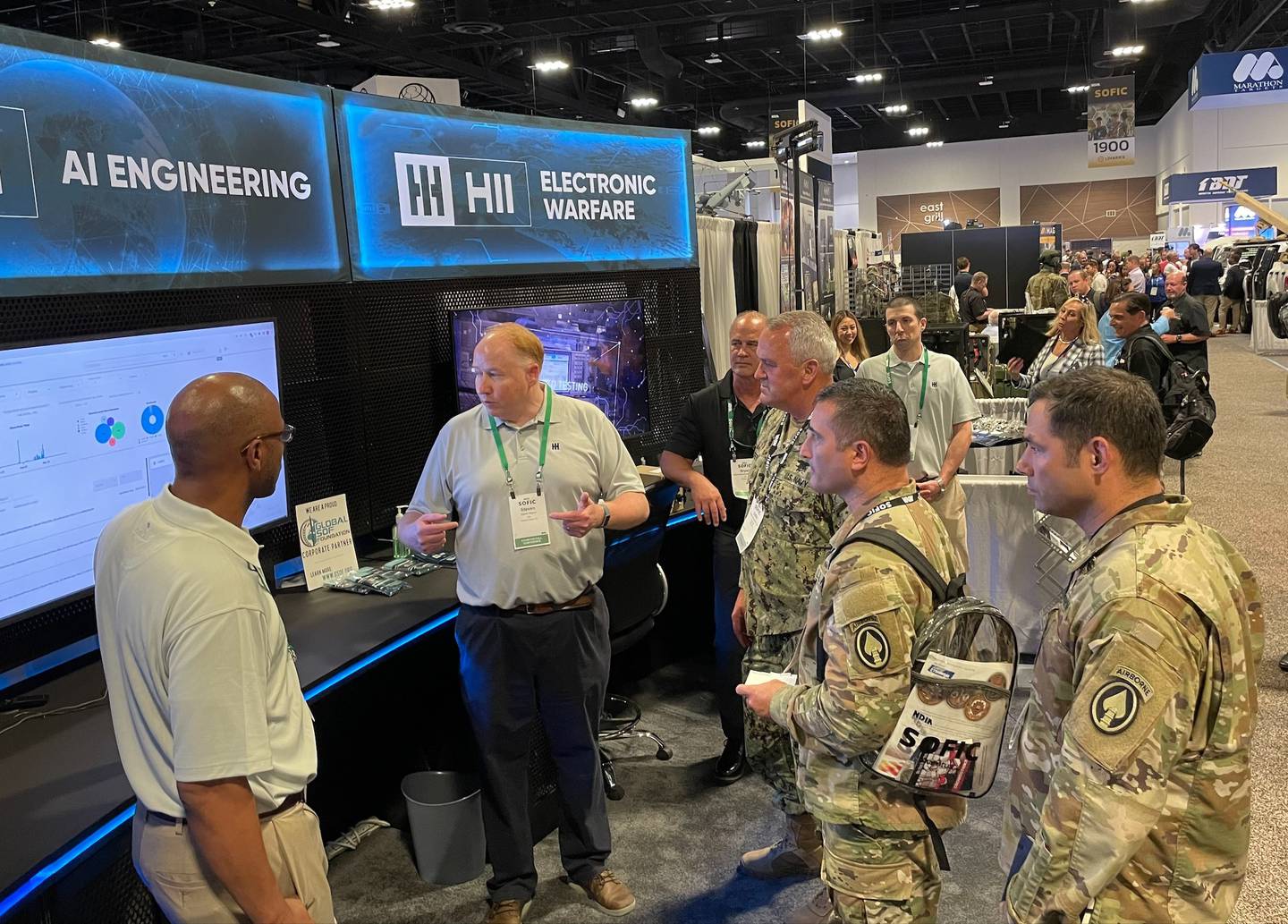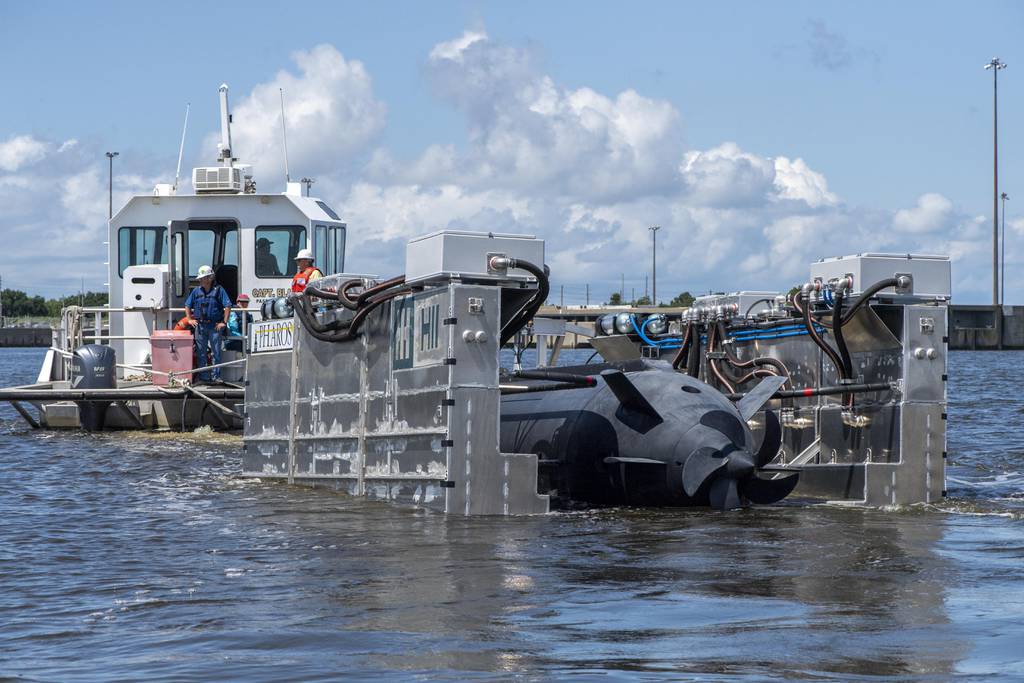WASHINGTON — A newly built-up division of American shipbuilder HII has several promising projects in development, and now also a contract with the Pentagon to marry them to urgent needs.
When HII — formerly called Huntington Ingalls Industries — rebranded in April as a global defense contractor, rather than just the largest U.S. shipbuilder, leaders spoke about the need to gain a foothold among the other armed services beyond the Navy. They also hoped to leverage the new Mission Technologies division to improve the company’s Ingalls Shipbuilding and Newport News Shipbuilding programs.
CEO Chris Kastner spent time with U.S. Pacific Fleet leadership in Hawaii last week as part of HII’s new direction, and to guide investments under a new technology development and demonstration contract with the Defense Department.
He told Defense News that a common theme among military leadership is “a desire to understand what we have available right now in [command, control, computers, communications, cyber, intelligence, surveillance and reconnaissance], and an ability to integrate different nodes within the common operating environment and provide that visibility very quickly to the warfighter.”
Through acquisitions in recent years, HII now has in-house experience in artificial intelligence, machine learning, unmanned systems, autonomous technology, sensors and battle management tools. While relevant to the military services and combatant commanders, these technologies are generally still undergoing research and development or are in prototyping phases.
But there’s still a demand. Kastner said his trip to Hawaii “reinforced that the investments we’ve made make a lot of sense because the tools that the customer is asking for are exactly the tools that we’ve invested in. [Intelligence, surveillance and reconnaissance], [artificial intelligence and machine learning], unmanned technology — the integration of all of those under a common operating picture.”
The challenge is that the military wants these technologies immediately — meaning the services can find small sums of money in the current year’s budget to support technology demonstration, but it’s still hard to find a path to larger profits via traditional contracts for a program of record.
Some recent efforts at HII are “probably not materially financially important right now to the corporation, but they’re strategically important to our customer,” Kastner explained.
So where does that leave the company and its shareholders?
Kastner said that earlier this month, the government awarded HII as Decisive Mission Actions and Technology Services task order that could serve as a model for translating emerging technology into substantive contracts.
The contract, which could be worth up to $826 million over five years, is intentionally broad, allowing the Mission Technologies division to mature and demonstrate technologies in support of “all DOD service components, component research labs, components of the DOD Fourth Estate, National Intelligence Agencies and Combatant Commands.”
“Within that contract, we are able to demonstrate technology to the customer and really to the [combatant commands] and say: ‘Look, we’re going to bring technology to bear on a problem that you have, we’re going to solve that for you, and that could eventually evolve into, potentially, programs of record,’ ” Kastner said. “It allows you to develop the technology the customer wants you to develop in a cost-plus environment.”
That perhaps marries the twin challenges of solving warfighting problems and making money for the company.
Kastner noted that Alion Science and Technology, which HII acquired in August 2021, had also signed a similar technology development and demonstration contract with the government in 2019 and that he looks forward to seeing what HII Mission Technologies can do with it.
Of particular interest is the ability to mature such a range of technologies. Though C5ISR is the primary focus, other emerging tech can contribute to that mission area. For example, unmanned systems can be outfitted with mission packages that contribute to C5ISR; and under this contract structure, HII could mature both the drone and the mission package, which could help the firm in the long run during unmanned vehicle competitions.

Multiservice provider
On Aug. 11, the Air Force awarded HII a Mobility Air Force Distributed Mission Operations task order to provide live, virtual and constructive training capabilities. HII will operate and maintain the Distributed Training Center and the Distributed Training Center Network, according to a company news release.
Kastner said the company was already a top LVC training developer for the Navy, and that the systems will apply well to this Air Force project. He also hopes to expand the company’s footprint within the Air Force’s training community and into that of the Army, among other customers.
On the shipbuilding side, he anticipates Mission Technologies will help traditional programs improve. For example, he said, the Gerald R. Ford-class aircraft carriers will provide significant work for the Newport News Shipbuilding yard in Virginia for the coming decades: hulls 79, 80 and 81 are on contract now, and Congress is already considering a two-ship buy for 82 and 83.
The Ford class is the first to have a digital design and digital work instructions for the builders. Kastner said the Mission Technologies division can help leverage that into a maintenance tool.
“We have a fully digital ship now in the Ford class, and if we can … create some predictive maintenance around it through AI/ML tools, it will absolutely increase the amount of time that ship is deployed because we can predict when things fail and get them repaired before they do,” he said, adding the company is internally funding this research.
He added that HII spoke to Navy and Defense Department officials about how this predictive maintenance tool could decrease maintenance costs and increase operational days over the 50-year life of each carrier.
Another internal research and development project looked at how to employ unmanned vessels from the well deck of Ingalls-built amphibious ships, something the company demonstrated in June.
Megan Eckstein is the naval warfare reporter at Defense News. She has covered military news since 2009, with a focus on U.S. Navy and Marine Corps operations, acquisition programs and budgets. She has reported from four geographic fleets and is happiest when she’s filing stories from a ship. Megan is a University of Maryland alumna.








